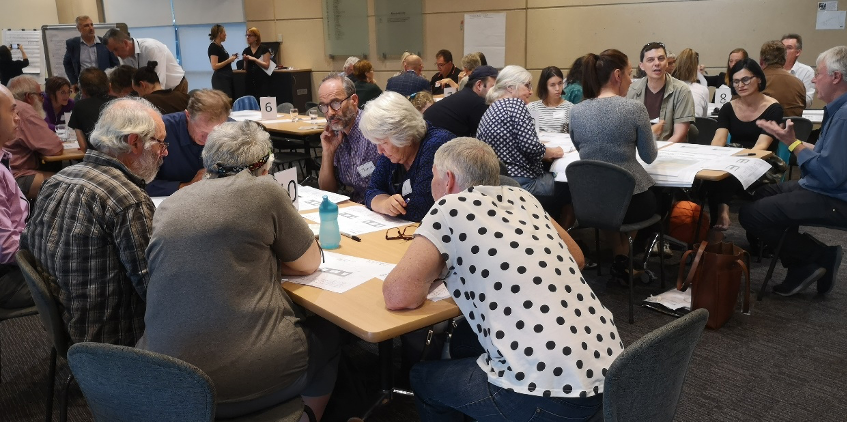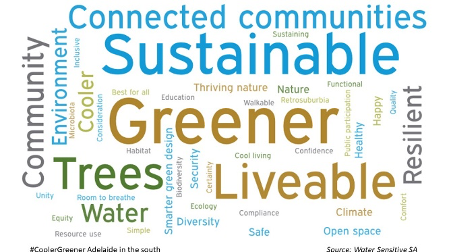SA communities support our infill designs

During February, Water Sensitive SA hosted four workshops to get the community thinking about implications for urban greening and stormwater management under South Australia’s new draft Planning and Development Code policies. To frame the discussions, the hosts used designs adapted from the CRCWSC’s draft infill typologies catalogue to demonstrate what a cooler greener future infill development could look like in South Australia compared with business as usual and the draft Code requirements.
And the good news is the 180 workshop participants overwhelmingly agreed the proposed infill development housing designs adapted from the CRCWSC’s new catalogue are their preferred options for future infill development in the state.
Water Sensitive SA compiled a response to the SA Government, based on the workshop outcomes.
You can access the latest version of the Infill typologies catalogue here and read more about the recent public release of the document here.
Here’s a bit more of a look at the SA workshop specifics:
In bringing together participants across four SA strategic locations—Woodville, Marion, Prospect and Salisbury—Water Sensitive SA aimed to:
- increase community understanding of the changes being proposed by the new Code as it relates to urban infill development, urban greening and sustainable water management outcomes
- explain the implications of the new Code and what it will mean for assessing infill development, emphasising the need to ensure the Code adequately supports urban greening and sustainable water management
- provide a rationale and understanding as to why the change is needed
- clearly articulate the timelines for finalising the Code and the limited time now available for community input
- activate the community to have their say via independent submissions to Planning SA and help them refine their thoughts and ideas about the proposed new Code
- benchmark the changes being proposed in the new Code against what is currently in place under the existing Planning Act
- give workshop attendees the chance to assess the proposed changes via a series of tangible scenarios against an the CRC for Water Sensitive Cities' Infill development evaluation framework that considers social, environmental and economic factors including water performance, urban space analysis and urban heat storage and release
- give participants the chance to propose further changes to the new Code that will deliver better social, environmental and economic benefits in the context of a changing climate.

During the workshops, participants considered:
- background information on the challenges associated with urban infill (i.e. canopy loss trends, and associated urban heat island effect and mental and physical health impacts; plus increases in stormwater runoff volume and peak flow rates, and associated decreases in stormwater quality reaching our rivers and coasts)
- an overview of the urban green cover and stormwater related policies within the draft Code
- a suite of scenarios giving a visual representation of the relevant policies, which demonstrated infill development designs for a typical single lot subdivided into four and 18 townhouses/group dwellings that:
- fall short of the Code policies (effectively ‘business as usual’)
- are minimum deemed-to-satisfy solutions (‘just meets the Code’ policies )
- exceed the Code policies (‘cooler, greener’ designs).
The participants looked at four design options provided by the CRCWSC’s IRP4 team (the authors of the infill typologies catalogue):
- 1 allotment into 2 – Just meets the Code, General Neighbourhood Zone
- 1 allotment into 3 – Just meets the Code, General Neighbourhood Zone
- 1 allotment into 4 – Housing Diversity Zone/Urban Renewal Neighbourhood Zone/Urban Corridor Zone
- 2 allotments into 16 – Cooler, greener design.
They assessed the performance of the designs across a range of social, environmental and economic criteria:
- site coverage
- stormwater runoff management
- private outdoor space
- communal outdoor space
- human thermal comfort (how does it feel)
- construction and whole of life running costs
- dwelling amenity and function.
What they found was overwhelming support for the proposed ‘cooler, greener’ and more water sensitive design option that exceeds the Code requirements. For future infill development, participants agreed they would most value designs that achieve sustainable, liveable, green, future-proofed, engaged, resilient urban communities. Exactly what water sensitive cities are all about, right?
